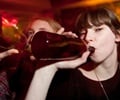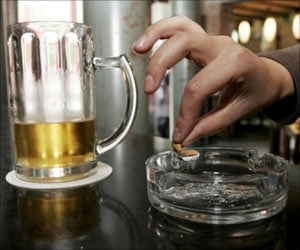Alcohol-related deaths, heavy drinking episodes and drunk driving have all been on the rise on college campuses over the past decade, a new government study shows.
Alcohol-related deaths, heavy drinking episodes and drunk driving have all been on the rise on college campuses over the past decade, a new government study shows.
Using figures from government databases and national surveys on alcohol use, researchers at the National Institute on Alcohol Abuse and Alcoholism (NIAAA) found that drinking-related accidental deaths among 18- to 24-year-old students have been creeping upward - from 1,440 in 1998 to 1,825 in 2005.At the same time, the proportion of students who reported recent heavy episodic drinking (sometimes called "binge drinking") rose from roughly 42 percent to 45 percent, and the proportion who admitted to drinking and driving in the past year increased from 26.5 percent to 29 percent.
"The fact that we're not making progress is very concerning," says lead researcher Ralph Hingson, Sc.D., M.P.H., director of the NIAAA's division of epidemiology and prevention research.
"The irony," he adds, "is that during this same time period, our knowledge of what works as far as intervention in this age group has increased. That knowledge isn't yet being put into place."
Hingson and his colleagues report the findings in a special supplemental issue of the Journal of Studies on Alcohol and Drugs devoted to college drinking problems. Fourteen studies in the issue report the results of projects funded by the NIAAA's Rapid Response to College Drinking Problems initiative - which, between 2004 and 2005, selected 15 college campuses with serious student-drinking issues to work with the agency and other experts in developing programs to combat the problem.
The resulting programs ranged from the individual level, like counseling for students found to have drinking problems, to community-level efforts that involved law enforcement and residents of neighborhoods surrounding college campuses. All showed their own benefits.
Advertisement
"There's no silver bullet for this," he says, "but the more levels at which we try to intervene, the more effective we'll be. Colleges and communities need to work together, because neither can do it alone."
Advertisement
Hingson points out that in 2000, only 17 U.S. states had made it illegal to drive with a blood alcohol content of .08 percent or higher; by 2005, all had adopted that limit. That, he says, may at least partially account for the dip in college students' drinking and driving.
Similarly, state laws that set the legal drinking age at 21 have been credited with reducing alcohol-related road deaths. An "interesting" finding from this study, Hingson notes, is that the increases in heavy episodic drinking, drinking and driving, and alcohol-related deaths were seen among 21- to 24-year-olds, and not 18- to 20-year-olds.
Source-Eurekalert
SRM











